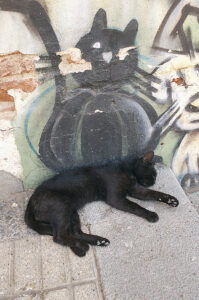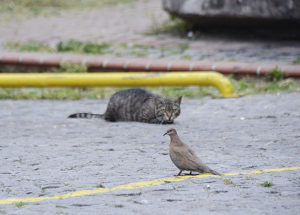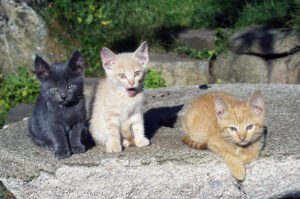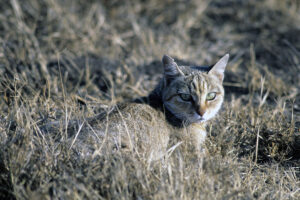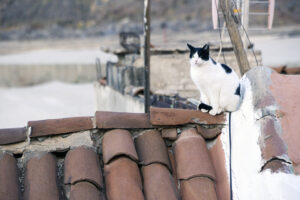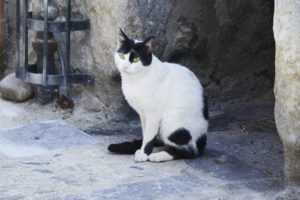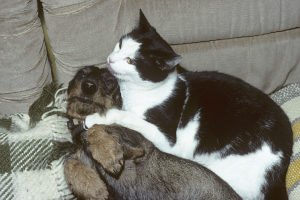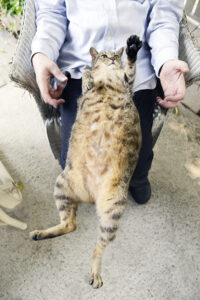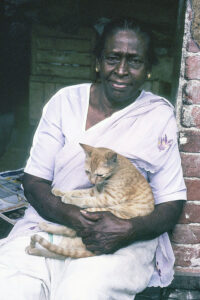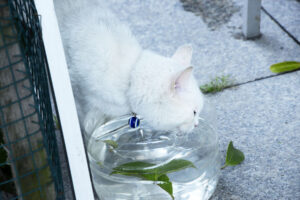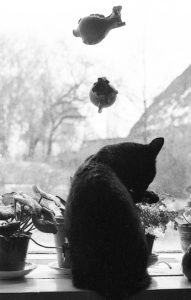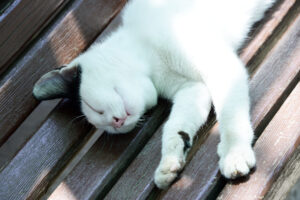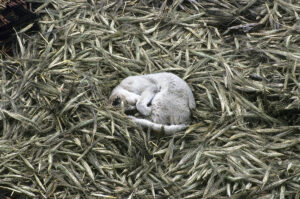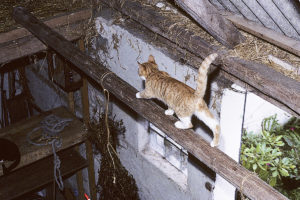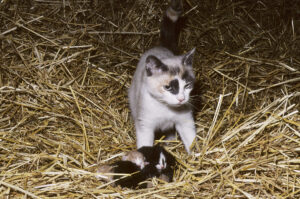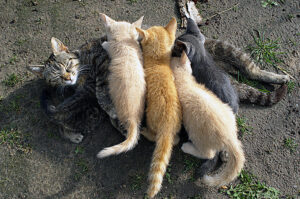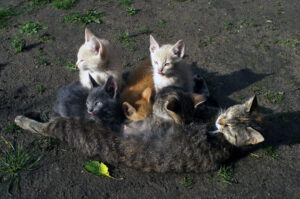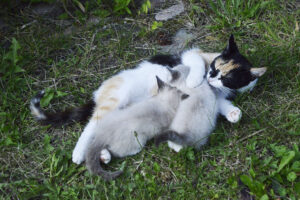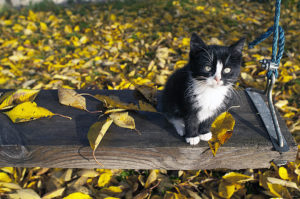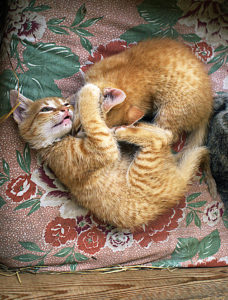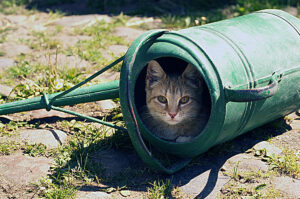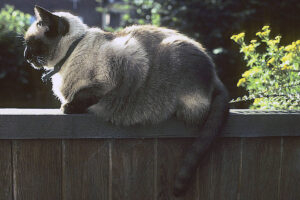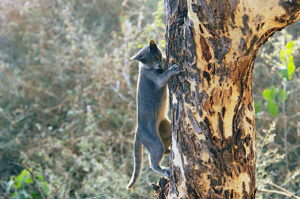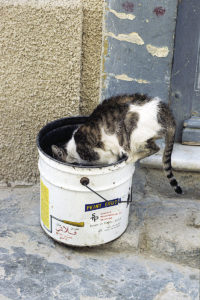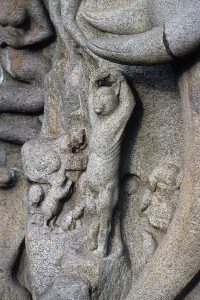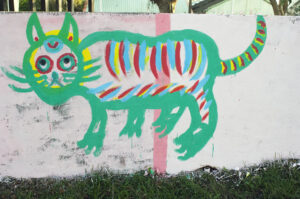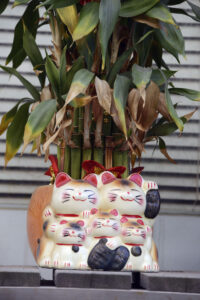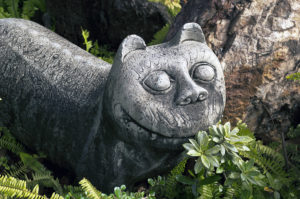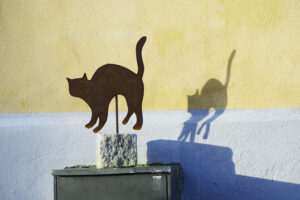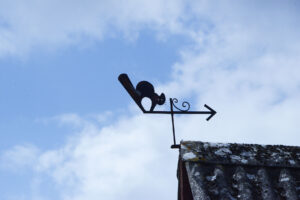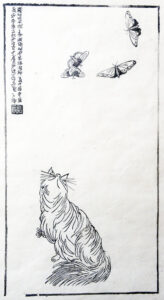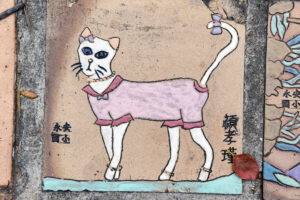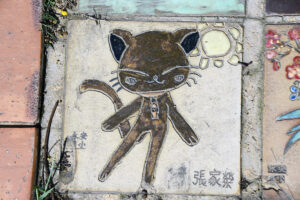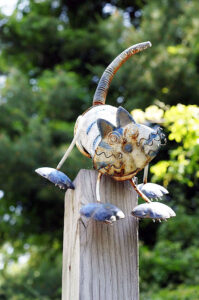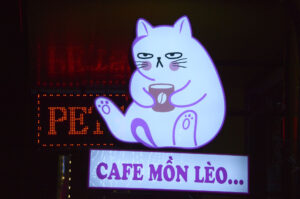Cat
Black cat, sleeping beneath a wall painting, depicting – a black cat, Valparaiso, Chile. (Photo copyright © by Kaj Halberg)
”That dove would make a perfect lunch!” – This cat in Istanbul, Turkey, is lying in wait for a palm dove (Spilopelia senegalensis), but misses it. (Photo copyright © by Kaj Halberg)
Kittens, Funen, Denmark. (Photo copyright © by Kaj Halberg)
When the cat’s away, the mice will play.
Old proverb.
Macavity’s a Mystery Cat: he’s called the Hidden Paw,
For he’s the master criminal who can defy the law.
He’s the bafflement of Scotland Yard, the Flying Squad’s despair:
For when they reach the scene of crime, Macavity’s not there!
First verse of the poem Macavity, the Mystery Cat, in a collection of poems, Old Possum’s Book of Practical Cats (1939), by American poet, writer, and editor Thomas Stearns Eliot (1888-1965).
Previously, it was believed that the domestic cat descended from the European wildcat (Felis silvestris). However, recent genetic research indicates that it descended from the African wildcat (F. libyca), which split off from the European wildcat about 170,000 years ago.
Despite its name, the African wildcat is not only found in Africa. As of today, 3 subspecies are recognized, the nominate in northern Africa, cafra in southern Africa, and ornata in the Arabian Peninsula, the Middle East, north-western India, and Central Asia, eastwards to Mongolia and northern China.
Archaeological evidence suggests that domestication of the African wildcat began around 7000 B.C. in Mesopotamia, when crops of early farmers were infested with rodents, which ate a large part of the harvest. The cats were clearly beneficial in controlling the rodent populations in the villages.
In Ancient Egypt, the cat was venerated as a sacred animal. The early goddess of justice and execution, the lion-headed Mafdet, was gradually replaced by Bastet, the cat goddess, who, over time, changed to become the goddess of fertility and motherhood. The cat was so sacred that thousands of cats were mummified after death, just as humans. In Egypt, cats were known not only to kill rodents, but also venomous snakes like cobras.
Today, the domestic cat is mainly a companion pet, found in almost all parts of the world. The total population is estimated at between 300 and 800 million. Like with the dog, there are more than 200 breeds, the largest of which is probably the North American Maine Coon, which can weigh up to 10 kilograms. Incidentally, this breed is not named after the raccoon (Procyon lotor), as one might think, but probably after an English captain, Charles Coon, who kept big, long-haired cats on board his ships.
The ancestor of the domestic cat is the African wildcat. This picture shows an individual of the southern African subspecies, Felis libyca ssp. cafra, resting in savanna grass, Serengeti National Park, Tanzania. Most African wildcats are a pale sandy-grey, with faint black stripes. (Photo copyright © by Kaj Halberg)
The domestic cat comes in a wide variety of colours, including greyish with black stripes or spots, black, white, red, fawn, and pied. When these kittens, all from the same litter, grew up, they spent the nights in this bird nesting box, Funen, Denmark. (Photo copyright © by Kaj Halberg)
Piebald cats, La Aldea de San Nicolas, Gran Canaria (top), and Cefalú, Sicily. (Photos copyright © by Kaj Halberg)
Cat on the prowl, Tunghai University Park, Taichung, Taiwan. (Photo copyright © by Kaj Halberg)
This fishmonger in the town of Çesmealti, near Urla, western Turkey, is popular among the local cats, as he feeds them with fish offal. (Photo copyright © by Kaj Halberg)
Cat on a fishing boat, Fangliao, Taiwan. (Photo copyright © by Kaj Halberg)
Usually, dogs and cats are sworn enemies, but if they grow up together, like this cat and wire-haired dachshund, they can be the best of friends. (Photo copyright © by Kaj Halberg)
Relaxed cat in an unusual resting position, Taiwan. (Photo copyright © by Kaj Halberg)
“Would you like a cat?” this Malayalam woman asked me at the Kannimera Market, Thiruvananthapuram, Kerala, India. (Photo copyright © by Kaj Halberg)
This cat is drinking from a glass bowl with fallen fig leaves, Istanbul, Turkey. (Photo copyright © by Kaj Halberg)
Cats spend a lot of time grooming. This cat is licking its paw on a window sill, Jutland, Denmark. (Photo copyright © by Kaj Halberg)
Cats spend most of the daytime hours sleeping.
These cats are sleeping in a wooden box, intended for kittens. They probably slept in it, when they were young, so they feel at home in it. – Funen, Denmark. (Photo copyright © by Kaj Halberg)
Sleeping cat, Izmir, Turkey. (Photo copyright © by Kaj Halberg)
Cat, sleeping in drying wheat, Siduwa, Arun Valley, eastern Nepal. (Photo copyright © by Kaj Halberg)
Cats have a fantastic sense of balance.
This cat is resting on a fence, Jutland, Denmark. (Photo copyright © by Kaj Halberg)
Kitten, walking along a beam in a barn, Jutland. (Photo copyright © by Kaj Halberg)
The gestation period of the domestic cat is 64 to 67 days. Kittens are very playful. When playing, they acquire skills, which are necessary later in their life, when they have to start hunting.
Cat with kittens, 2 weeks old, in a hay loft, Jutland, Denmark. (Photo copyright © by Kaj Halberg)
Suckling kittens, Funen, Denmark. (Photos copyright © by Kaj Halberg)
This kitten is sitting on a swing, surrounded by fallen leaves of a large cherry tree, Funen. (Photo copyright © by Kaj Halberg)
Kittens, playing on a pillow, Funen. (Photo copyright © by Kaj Halberg)
These kittens are playing on a discarded sofa in a hay loft, Jutland. (Photo copyright © by Kaj Halberg)
One of these kittens is trying to climb up my trouser leg, and another one is sitting on my foot. – Funen. (Photo copyright © by Kaj Halberg)
Playful kitten, biting a vine, Jutland. (Photo copyright © by Kaj Halberg)
Kittens are also very curious, investigating everything. This one has crept into a water jug. – Funen. (Photo copyright © by Kaj Halberg)
Cat breeds
As its name implies, the Siamese cat originated in Thailand, formerly called Siam. In the 19th Century, it became one of the most popular breeds in Europe and North America.
This cat, resting on a fence in Århus, Denmark, has some Siamese blood, but is more powerfully built than the lithe Siamese proper. (Photo copyright © by Kaj Halberg)
The Burmese cat originated on the border between Thailand and Myanmar (or Burma, as it was formerly called), but the race proper was developed in England and the United States.
Burmese cat, climbing down the trunk of an acacia tree, Bagan, Myanmar. (Photo copyright © by Kaj Halberg)
Homeless cats are a big problem in many parts of the world, as they compete with small indigenous predators, and they constitute a serious threat to the wild fauna. For instance, a study from 2013 suggested that free-ranging domestic cats (mostly feral) are the top human-caused threat to wildlife in the U.S., killing an estimated 1.3-4 billion birds and 6.3-22.3 billion mammals annually. (Source: S.R. Loss, T. Will & P. Marra 2013. The impact of free-ranging domestic cats on wildlife in the United States, Nature Communications 4:1396)
This homeless cat in Sousse, Tunisia, is searching for food in a garbage can. (Photo copyright © by Kaj Halberg)
Cats in culture and artwork
Similar to the dog, the cat is an important element in various cultures and is often depicted in artwork.
Just outside the town of Mamallapuram, Tamil Nadu, South India, a huge sculpture, measuring c. 15 by 30 m, has been carved into two boulders. The main theme of this sculpture, which has been dubbed The Descent of the Ganges, is an event in the Hindu epic Mahabharatha.
Bhagiratha was a great king, doing penance for a thousand years to obtain the release of his 60,000 great-uncles from the curse of Saint Kapila, eventually leading to the descent of the goddess Ganga to Earth, in the form of River Ganges.
Many other themes have been depicted in the sculpture, including elephants, antelope, and cats.
This detail of the sculpture The Descent of the Ganges shows a cat, dancing beneath an elephant. (Photo copyright © by Kaj Halberg)
In a suburban area in the city of Taichung, Taiwan, a retired soldier has adorned an entire neighbourhood – walls, streets, doors – with colourful paintings. For this reason, the area has been dubbed Tsai Hung Tsun (‘Rainbow Village’).
Colourful cat on a wall. (Photo copyright © by Kaj Halberg)
Flowerpot, depicting five happy cats, Taichung, Taiwan. (Photo copyright © by Kaj Halberg)
In the Wat Pho Temple, Bangkok, Thailand, I encountered this sculpture, depicting a smiling cat. (Photo copyright © by Kaj Halberg)
Cat, carved in metal, Funen, Denmark. (Photo copyright © by Kaj Halberg)
This wall painting, depicting an artsy cat, was observed in Taichung, Taiwan. (Photo copyright © by Kaj Halberg)
Weather vane, depicting a cat, Triberga, Öland, Sweden. (Photo copyright © by Kaj Halberg)
Chinese print on rice paper: Cat and butterflies. (Photo copyright © by Kaj Halberg)
Tiles with children’s art, Central Taiwan Science Park, Taichung, Taiwan. (Photos copyright © by Kaj Halberg)
Cat, made from metal parts, Lexington, Kentucky, United States. (Photo copyright © by Kaj Halberg)
I wonder if the coffee is tasty? The cat looks a bit dissatisfied. – Illuminated sign outside a café, Hanoi, Vietnam. (Photo copyright © by Kaj Halberg)
This paper lantern, depicting Disney’s Aristocats, was exhibited during the Festival of Lanterns, celebrated during Chinese New Year 2005 (the Year of the Rooster in the Chinese Zodiac), which took place in the city of Tainan, Taiwan. (Photo copyright © by Kaj Halberg)
Other members of the cat family are described on the pages Animals – Mammals: Lion – king of the savanna, and Animals – Mammals: The spotted killer, which deals with the leopard. Others are shown in the gallery at Animals: Cats.
(Uploaded September 2017)
(Latest update October 2024)
